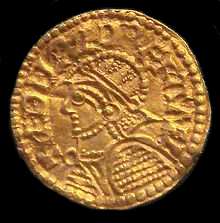








Designed by Nigel G Wilcox






The Paragon Of Metal Detecting
& Archaeology
& Archaeology
Powered By Sispro1
Anglo-Saxon & Viking A.D. - Currency Numismatics,
Mancus
For Reference ONLY
Everything For The Detectorist
Copyright All Rights Reserved by Nigel G Wilcox E-Mail: ngwilcox100@gmail.com
Viking Menu
Viking Timeline
Anglo-Saxon Timeline
| 1. Estimated value 2014 : |
1.
Offa 657-796 AD
1. A mancus, or gold dinar of the English king Offa of Mercia (757-796), a copy of the dinars of the Abbasid Caliphate (774). It combines the Latin legend OFFA REX with Arabic legends. The date of A.H. 157 (773-774 AD) is readable. British Museum.
Mancus (sometimes spelt mancosus or similar) was a term used in early medieval Europe to denote either a gold coin, a weight of gold of 4.25g (equivalent to the Islamic dinar, and thus lighter than the Byzantine solidus), or a unit of account of thirty silver pence. This made it worth about a month's wages for a skilled worker, such as a craftsman or a soldier. Distinguishing between these uses can be extremely difficult: the will of the Anglo-Saxon king Eadred, who died in 955, illustrates the problem well with its request that 'two-thousand mancuses of gold be taken and minted into mancuses' (nime man twentig hund mancusa goldes and gemynetige to mancusan).
Mancus (sometimes spelt mancosus or similar) was a term used in early medieval Europe to denote either a gold coin, a weight of gold of 4.25g (equivalent to the Islamic dinar, and thus lighter than the Byzantine solidus), or a unit of account of thirty silver pence. This made it worth about a month's wages for a skilled worker, such as a craftsman or a soldier. Distinguishing between these uses can be extremely difficult: the will of the Anglo-Saxon king Eadred, who died in 955, illustrates the problem well with its request that 'two-thousand mancuses of gold be taken and minted into mancuses' (nime man twentig hund mancusa goldes and gemynetige to mancusan).


Mancus
Pages
Main Coin Menu
Anglo-Saxon
Menu
Menu
Member NCMD
A.S. Menu
Information Data
























